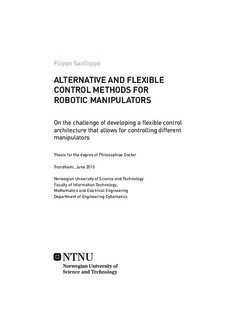| dc.description.abstract | Robotic arms and cranes show some similarities in the way they operate and in the way they are designed. Both have a number of links serially attached to each other by means of joints that can be moved by some type of actuator. In both systems, the end-effector of the manipulator can be moved in space and be placed in any desired location within the system’s workspace and can carry a certain amount of load. However, traditional cranes are usually relatively big, stiff and heavy because they normally need to move heavy loads at low speeds, while industrial robots are ordinarily smaller, they usually move small masses and operate at relatively higher velocities. This is the reason why cranes are commonly actuated by hydraulic valves, while robotic arms are driven by servo motors, pneumatic or servo-pneumatic actuators. Most importantly, the fundamental difference between the two kinds of systems is that cranes are usually controlled by a human operator, joint by joint, using simple joysticks where each axis operates only one specific actuator, while robotic arms are commonly controlled by a central controller that controls and coordinates the actuators according to some specific algorithm. In other words, the controller of a crane is usually a human while the controller of a robotic arm is normally a computer program that is able to determine the joint values that provide a desired position or velocity for the end-effector. If we especially consider maritime cranes, compared with robotic arms, they rely on a much more complex model of the environment with which they interact. These kinds of cranes are in fact widely used to handle and transfer objects from large container ships to smaller lighters or to the quays of the harbours. Therefore, their control is always a challenging task, which involves many problems such as load sway, positioning accuracy, wave motion compensation and collision avoidance.
Some of the similarities between robotic arms and cranes can also be extended to robotic hands. Indeed, from a kinematic point of view, a robotic hand consists of one or more kinematic chains fixed on a base. However, robotic hands usually present a higher number of degrees of freedom (DOFs) and consequentially a higher dexterity compared to robotic arms. Nevertheless, several commonalities can be found from a design and control point of views. Particularly, modular robotic hands are studied in this thesis from a design and control point of view.
Emphasising these similarities, the general term of robotic manipulator is thereby used to refer to robotic arms, cranes and hands. In this work, efficient design methods for robotic manipulators are initially investigated. Successively, the possibility of developing a flexible control architecture that allows for controlling different manipulators by using a universal input device is outlined. The main challenge of doing this consists of finding a flexible way to map the normally fixed DOFs of the input controller to the variable DOFs of the specific manipulator to be controlled. This process has to be realised regardless of the differences in size, kinematic structure, body morphology, constraints and affordances. Different alternative control algorithms are investigated including effective approaches that do not assume a priori knowledge for the Inverse Kinematic (IK) models. These algorithms derive the kinematic properties from biologically-inspired approaches, machine learning procedures or optimisation methods. In this way, the system is able to automatically learn the kinematic properties of different manipulators. Finally, a methodology for performing experimental activities in the area of maritime cranes and robotic arm control is outlined. By combining the rapid-prototyping approach with the concept of interchangeable interfaces, a simulation and benchmarking framework for advanced control methods of maritime cranes and robotic arms is presented.
From a control point of view, the advantages of releasing such a flexible control system rely on the possibility of controlling different manipulators by using the same framework and on the opportunity of testing different control approaches. Moreover, from a design point of view, rapidprototyping methods can be applied to fast develop new manipulators and to analyse different properties before making a physical prototype. | nb_NO |
